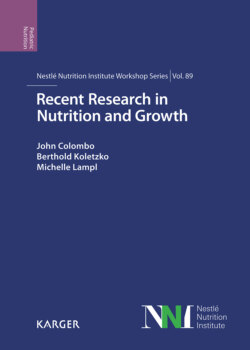Читать книгу Recent Research in Nutrition and Growth - Группа авторов - Страница 30
На сайте Литреса книга снята с продажи.
Regulation
ОглавлениеThe activity of chondrocytes in the growth plate is influenced by genetic, hormonal, and metabolic factors [30], which can act on the cells either directly (e.g., via hormonal receptors and/or secondary messengers) or indirectly (e.g., as a consequence of deficiencies, most notably in vitamin D3). The physiological routes via which growth performance can be regulated are limited, in so far as the targeted parameter must necessarily be either a structural manifestation of an individual chondrocyte in a cellular stack, which represents the functional unit of bone elongation, or exert an effect on the rate of cell proliferation or matrix production. Theoretically, an increase in the linear growth rate of a bone could be achieved by enhancing the hypertrophic activity of growth plate chondrocytes (with resulting increases in the final height and volume of the terminal hypertrophic chondrocytes and in the mass of extracellular matrix that is produced per cell) or by augmenting the production of new cells in the resting zone, which would lead to an increase in the “growth fraction,” or in the proliferative one, which would be achieved by a shortening of the cycling time. Of course, these alternative mechanisms need not be mutually exclusive – they could be combined [9].
The mechanisms that are implicated in the regulation of bone elongation can be conveniently investigated under physiological conditions during the “prepubertal” growth spurt. Some years ago, the author addressed this issue in a comparative study involving young (21-day-old), “prepubertal” (35-day-old), and aging (80-day-old) rats [9]. The daily longitudinal growth rate in the proximal tibial growth plate was revealed to be 20% higher in the 35-day-old than in the 21-day-old rats (330 vs. 276 µm/day). This acceleration of the growth rate was not achieved by an increase in the number of rapidly proliferating cells per column (viz, in the “growth fraction”) but exclusively by a 20% increase in the final height of the terminal hypertrophic chondrocytes (from 31.2 µm in 21-day-old rats to 38.5 µm in 35-day-old ones). The final volume of the terminal hypertrophic chondrocytes and the net volume of matrix that was produced per cell remained almost unchanged.
During the course of aging (comparison between 35-day-old and 80-day-old rats), the daily growth rate decreased by 75% (from 330 µm/day in the 35-day-old rats to 85 µm/day in the 80-day-old ones). In contrast to the acceleration in the daily longitudinal growth rate that occurred during the “prepubertal” growth spurt, the deceleration that was associated with the process of aging could not be accounted for exclusively by a decrease in the final height of the terminal hypertrophic chondrocytes, which was reduced by 50% [9]. To achieve the full 75% decrease in the daily longitudinal growth rate, the number of rapidly proliferating cells per column (viz, the “growth fraction”) was reduced by 50% (from 18 to 9, with 4 instead 8 cells per column being generated and eliminated per day). The cycling time of the rapidly proliferation cells remained constant at 55 h. These findings indicate that the rate at which the slowly proliferating cells in the resting zone were fed into the proliferative one was depressed, viz, their cycling time was prolonged.
With a view to elucidating the roles that are played by pertinent hormones and growth factors in the regulation of longitudinal growth rate in rats, the author investigated the effects of the human growth hormone and those of the insulin-like growth factor I, which target different cells in the growth plate [5]: the human growth hormone acts on cells in the resting and the proliferative zone, whereas the insulin-like growth factor I exerts an influence exclusively on the latter pool. To exclude the influences of intrinsic pools of the human growth hormone and the insulin-like growth factor I and to arrest longitudinal bone growth, rats were hypophysectomized. Under the influence of the human growth hormone, the proliferative activity of the cells in the resting zone was augmented, which resulted in an increase in the number of rapidly proliferating cells in the proliferative zone (viz, in the “growth fraction”), the proliferative activity of which was also expedited. The longitudinal growth of the proximal tibial bone was resumed but not restored to the prehypophysectomy level, owing to the continued absence of the thyroid-stimulating hormone and thyroxin, which coregulate the hypertrophic activity of growth plate chondrocytes [30].
In contrast to the author’s expectation, the insulin-like growth factor I stimulated not only the chondrocytes in the proliferative zone, which was a well-documented finding, but also those in the resting zone, thereby resulting in an increase in the “growth fraction” (viz, in the number of rapidly proliferating cells in the proliferative zone), albeit not to the extent that was achieved under the influence of the human growth hormone. The insulin-like growth factor I also stimulated the hypertrophic activity of chondrocytes, which was likewise an unexpected finding.
Many other hormones, too numerous to mention here, are known to influence the activities of chondrocytes in the growth plate, and the mechanisms at play are complex. But worthy of special note are the sexual hormones, which play a key role in the prepubertal growth spurt, as well as in the physiological termination of longitudinal bone growth [31].
